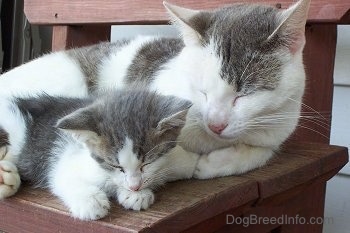
Little Lou as a kitten sleeping next to Snowball a full grown cat.
Warm-blooded feline, carnivorous mammal domesticated as a catcher of rats, mice and as a pet. (Felis catus)
The domestic cat is a very intelligent, very independent animal. They only do what they feel like doing, when they feel like doing it. They will not hesitate to demand whatever they want, be it food, play, or to be left alone. Cats have different personalities. Some are the quiet type, while some meow all the time, some are fussy and very selective about food and people and some will eat anything and want attention from every person. Some like to be held and to sit on laps and some are loners and do not want much to do with people. When a cat wants to get your attention it will either endlessly meow at you, rub against your leg or follow you around. Some cats are smarter than others. Some really seem to be paying attention to the world around them—watching, listening and taking in all that is going on as if they really understand it all. Some outdoor cats have even been known to look both ways before crossing the street. Cats are capable of all kinds of intelligent and sometimes surprising behavior. Some cats enjoy watching TV and even listening to the radio. You can tell if your cat is relaxed by lifting it up; a relaxed cat is loose and light, and a scared cat is tight and heavy. Some may even learn to do tricks, just like dogs! Cats like to take many short naps during the day, hence the expression ”cat nap.” Where they choose to sleep varies with their personality. Some like to sleep in places like high cupboards, secluded and out of the way, while others like to be right amongst all the action. Some like soft warm places, others like sunny nooks and crannies. Cats have a tendency to sharpen their claws and they may do this in places you do not wish them to do so, i.e. the couch. Giving the cat a place where he can sharpen his claws such as a scratching post and keeping the claws cut short is recommended. Giving your cat a scratching post covered in carpet is not always the best idea as it will be teaching your cat that scratching fabric is OK, i.e. your couch. Instead, the scratching post should be sisal rope or carpet turned inside out. With some effort, cats can be taught that the scratching post is the designated scratching area. Some choose to declaw their cats. Declawing a cat is the surgical removal of the cat’s toenails, however this is very painful for the cat as a cat’s claw is actually a movable digit attached to muscle—the same as a finger. It has strong ligaments and tendons which give power to extend and retract the claws. A declawed cat can no longer properly grasp, hold or establish footing for proper walking, running, springing, climbing or stretching, and therefore should never be let outside of the house. It will no longer be able to properly defend itself or climb a tree to get away from predators.
Besides the fact that there is a great overpopulation of cats without homes, there are many other good reasons to get your cat spayed or neutered. Unaltered male (and sometimes female) cats may start to spray their urine around your house to mark their territory. The intact cat's urine is especially foul-smelling and can never be completely cleaned from things such as carpet, upholstery, bedding or wood. Females in heat will howl, pace and may soil in the house. This can last up to 21 days and occur three or more times a year. While a female cat is in heat, male cats looking for romance will howl outside your door. Unaltered cats have an urge to roam far from the house looking for a mate and may travel great distances in search of a mate, risking dangers from cars, cat fights and possibly upsetting neighbors. Spayed and neutered cats are more likely to be calmer, healthier and more content. Studies show that spayed and neutered cats have average life expectancies twice as long as those of unspayed and unneutered cats.
Varies depending on the breed
For adults:
About 6-15 pounds (2.7 to 7 kilograms)
Some cats weigh more than 20 pounds (9 kilograms).
About 8-10 inches (20-25 cm) tall at the shoulder.
Cats can live solely indoors, indoors and outdoors, or solely outdoors. Cats that are kept solely outdoors need to have some sort of shelter provided, such as a barn. Cats are one of the essential elements on a working farm. They control the rodent population, keeping them out of the feed. One farmer reports that he had a rat in every stall of his barn until he brought cats into his establishment. Since then he has not seen a single rat. Cats cannot be kept in cages such as rabbit hutches; they must live inside your home or free outside. A cat will go crazy if confined to a small cage for a long period of time. If you plan to keep your cat outdoors first consider the area you live, as some areas are not safe for a cat to live outdoors. A cat is a good pet for apartment life.
Indoor cats need to have a litter box provided where they can eliminate. Litter boxes need to be scooped daily and thoroughly changed and cleaned at least twice a week. Cats do not like to eliminate in dirty places, therefore, if you do not keep the litter box clean to your cats liking, your cat will find other places to go. This will most likely not be a place of your choice!
Cats are very clean animals. In general they will take care of their own grooming needs, grooming themselves with their rough tongue. Some long-haired cats may need to be brushed. A cat that suddenly stops grooming itself may be showing signs of illness and should be taken to the vet for a checkup. Cats’ whiskers should never be cut as they are used for balance; their tail is also used for balance.
Cats, unlike dogs, are true carnivores, which means they thrive on meat-only diets and require no vegetable, grain or dairy supplementation. Cats can be fed high-protein dry or canned food made just for cats. While canned food is tastier for the cat, dry food is better for their teeth. Some like to feed a combination of dry and canned. Be sure to pick a high-quality food, with the main ingredient being a meat and not a meal or by-product. Cats are hunters and need meat to be healthy. They have a higher protein requirement than many other mammals and are unable to adjust to a low-protein diet and will use body protein to satisfy their needs. There are many other nutrients and amino acids found in meat that cats need to be healthy. Contrary to popular belief, cow’s milk is not good for cats. The proteins in cow milk are too large for cats to properly digest which can cause intestinal upset, diarrhea and vomiting. If fed dry food, cats can either be fed by free-choice feedings or scheduled feedings. Cats that are fed by free-choice will usually eat every few hours all day long. If obesity is a problem, or only canned food is fed, scheduled feeding, that is, feeding a specific amount of food at specified regular mealtimes, is recommended. Fresh clean water should be provided at all times.
Most cats will exercise on their own, dashing through the house, leaping across the furniture, chasing a bug or swatting at the family dog. Young cats like to play and will find ways to entertain themselves. They will also enjoy it if you play with them. There are many great toys made just for cats, however things such as a rolled up sock will also work.
On average cats live to be 12-14 years old. Some have been known to live more than 20 years.
About 1 to 9 kittens with an average of 3 to 5
Some of the most common feline health problems are colds and sniffles, i.e. respiratory viruses, urinary problems and digestive problems. If your cat vomits more than 24 hours or vomits and acts depressed, call your vet. Eye problems—if your cat is squinting only in one eye there may be something in its eye. If you cannot remove it, take your cat to the vet. Conjunctivitis is an inflammation of the conjunctiva membrane. It can become swollen and reddened often making it more visible. Conjunctivitis can affect one or both eyes. Cats with conjunctivitis tend to have a discharge from their eye(s) which can be clear and watery or thick with a pus-like appearance. If you think your cat has conjunctivitis call your vet. Bite wounds and abscesses (mainly in outdoor cats)—can usually be prevented if antibiotics are given within the first 24 hours after the wound is inflicted. Never give cats aspirin, Tylenol or similar human medications. All cats should be taken to the vet regularly for shots, immunizations and check-ups. Cats with live with Feline herpes virus (rhinotracheitis virus) is a very common upper respiratory virus of cats, especially for those that live with multiple cats or those that are in contact with new cats. Barn cats are often affected. The virus is spread through the air. It replicates in the upper respiratory track affecting the tonsils, nasal area and the conjunativa of the eye is often also affected. The virus remains latent in the nerves that serve the eyes. When a cat is stressed or exposed to new serotypes (different strains) of herpes virus, the ocular disease can recur. Keeping cats that are affected with this virus on a natural supplement called lysine can stop an outbreak or cure an existing one. Lysine is an essential amino acid. It competes with another amino acid, arginine, that herpes virus must have in order to reproduce. It is that virus that often spreads among farm cats causing them to get respiratory issues and goopy eyes. It is sold in forms of powder, gel and even treats (which most cats love). You can treat a sick cat with it, or put the powder on food to prevent it.
A female cat can go into heat as often as every two weeks until she is either pregnant or spayed. Female cats in heat will go to any lengths to get outside and mate. They will scream and howl calling for a mate. The gestation period for a cat is typically from 57 to 69 days, with the average of 63 to 64 days. Litter size can vary from one to eight kittens with the average litter size of two to five kittens. Female cats can have up to three litters a year.
Cats were first domesticated in Egypt, where they soon spread to Asia, Europe and the rest of the world. The domestic cat is a direct descendant from, or a subspecies of, the African wildcat. It is placed in the genus Felis, which represents the domestic cat lineage—the second oldest branch of the Felid family tree. Cats were first domesticated over 5000 years ago. They are now one of the most popular pets in the world. In several countries, including the United States and the United Kingdom, there are more cats than any other pet. Domestic cats now live on every continent except Antarctica and have evolved into over fifty distinct breeds.
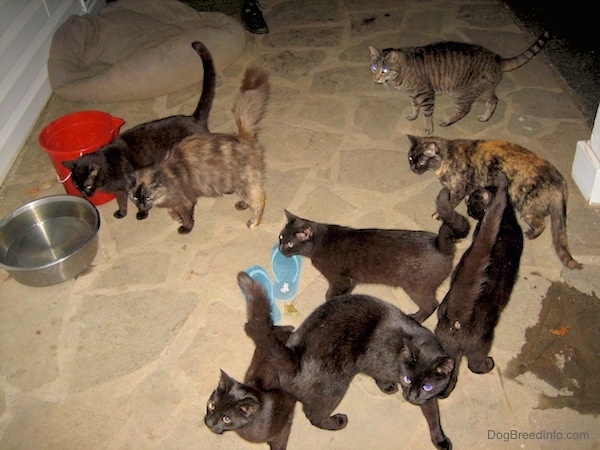
Farm cats on a stone porch
Cats groom themselves daily. This is Shadow Kitty keeping herself all nice and clean.
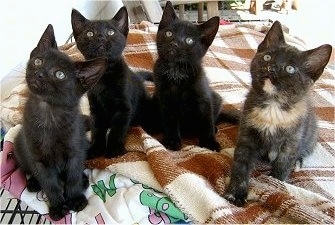
7-week-old kittens—from left: Clover, Suga, Midnight III, Talic
Dusty sitting on top of her dog friend's kennel
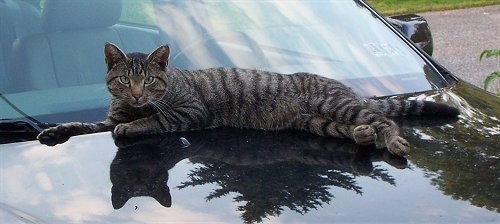
"This is Whiskers, a feral cat. Whiskers is one of five kittens found living under some boards at the Maguire Farm, along with the mom cat. The mom cat and kittens were all wild. Having a farm, we decided the wild cats were more than welcome to stay. Knowing winter was coming we decided to try and tame the kittens. We captured the kittens and handled them every day. The kittens were wild and would try and bite us when we handled them. We named the mom cat Mom-Cat and the kittens Nasty-One, Nasty-Two, Nasty-Three, Nasty-Four and Nasty-Five. We had to wear heavy gloves to handle them. The mom cat was upset her kittens were in a cage so we let her have two of them back. We continued to try and tame the other three. We were somewhat successful with the remaining three. The mom and the two kittens we let go were hanging around the barn because of the food we put out. Even the mom was becoming slightly more friendly. We eventually let all of the kittens go. They hung out around the barn for months until they all eventually disappeared. They were all gone for months. One day we heard a cat crying. We looked around and saw Whiskers on the barn roof. My daughter climbed up onto the roof (it is ground level on one side) and picked Whiskers up. He was skin and bones and very hungry. She carried him to a bowl of food. Whiskers never left again. He lives right on our porch. My daughter is the only one who can hold him. He comes really close to us and will rub against our legs, but does not like to be held or touched. If we reach down to pet him he will dart away and come back to rub our legs when he thinks we are not looking. The only time he will semi tolerate being petted is while he is eating. We can always count on Whiskers being right outside our door. He never goes far from the house (the cats are all fed on the porch). Once in a while we will spot another Nasty-Cat, but they do not hang around like Whiskers does. We think they hang out at another barn in the area. Two other Nasty-Cats hung out enough to earn real names. One black female was named Claudia and one of the other male tiger kittens was named Cutie-Pie (my daughter called him Cute-Stuff), however we have not seen these cats in quite some time now. Like all of our barn cats, Whiskers has his shots and is neutered, thanks to the wonderful house calls of my awesome vet!"
"One-Eyed Hammy is a feral cat who ended up at the Maguire Farm by mistake. A load of hay was being delivered. When the van doors opened, out jumped Hammy, who was apparently hitching a ride! He ran off as fast as he could. We thought we'd never see him again. However a few days later he was spotted on the barn roof. I took a picture of him and when I zoomed in on the picture, not only did I realize he had a cold, but he also only had one eye! His missing eye was completely gone out of the socket. One can only imagine how that happened. We also realized he could not hear. There was nothing we could do about the missing eye and the loss of hearing, but we could do something about the cold. We started wrapping antibiotics in Velveeta cheese and tossing them to him. To our delight, if we moved far enough away from him, he'd eat the cheese along with the pill. One-Eyed Hammy, as we now call him, would still not come near us. He stayed very far away. However, over time we were able to get closer and closer. We even touched him once. He no longer runs when he sees us. He sleeps in the barn with Little Lou, our best mouser cat. We still cannot get close enough to really pet him, but he does not run when he sees us and that's a huge leap. Maybe someday we'll be able to get close enough to give him some good old kitty love. Perhaps someday..."
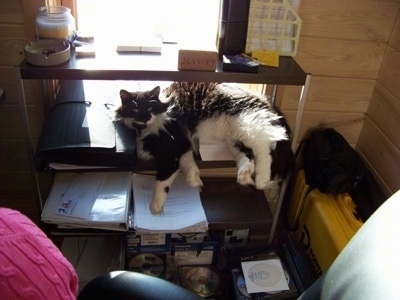
"Sylvester our cat who has to be in the middle of everything we do. Kay was doing payroll and he had to be right there."
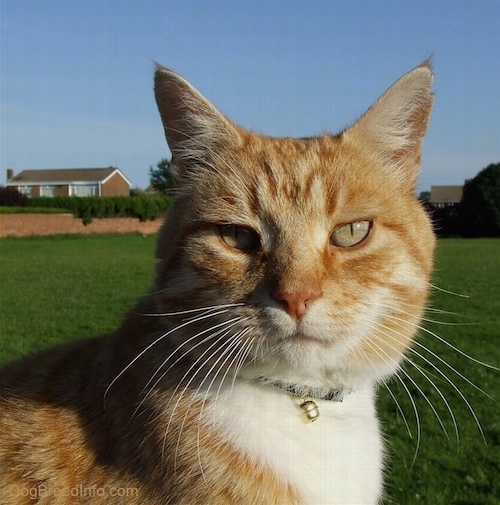
An orange tabby cat from the highlands of Scotland